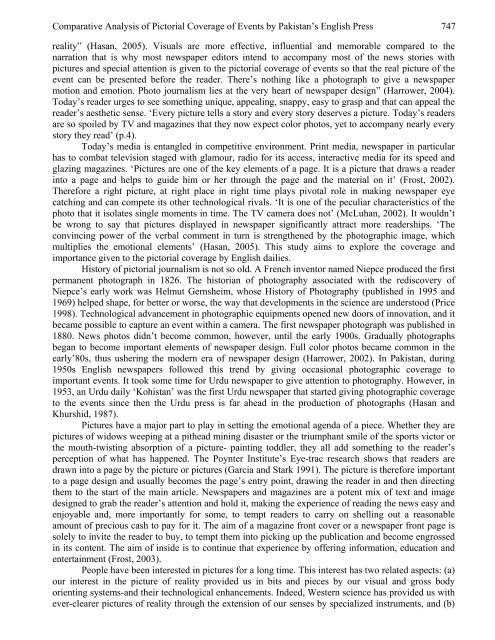European Journal of Scientific Research - EuroJournals
European Journal of Scientific Research - EuroJournals
European Journal of Scientific Research - EuroJournals
You also want an ePaper? Increase the reach of your titles
YUMPU automatically turns print PDFs into web optimized ePapers that Google loves.
Comparative Analysis <strong>of</strong> Pictorial Coverage <strong>of</strong> Events by Pakistan’s English Press 747<br />
reality” (Hasan, 2005). Visuals are more effective, influential and memorable compared to the<br />
narration that is why most newspaper editors intend to accompany most <strong>of</strong> the news stories with<br />
pictures and special attention is given to the pictorial coverage <strong>of</strong> events so that the real picture <strong>of</strong> the<br />
event can be presented before the reader. There’s nothing like a photograph to give a newspaper<br />
motion and emotion. Photo journalism lies at the very heart <strong>of</strong> newspaper design” (Harrower, 2004).<br />
Today’s reader urges to see something unique, appealing, snappy, easy to grasp and that can appeal the<br />
reader’s aesthetic sense. ‘Every picture tells a story and every story deserves a picture. Today’s readers<br />
are so spoiled by TV and magazines that they now expect color photos, yet to accompany nearly every<br />
story they read’ (p.4).<br />
Today’s media is entangled in competitive environment. Print media, newspaper in particular<br />
has to combat television staged with glamour, radio for its access, interactive media for its speed and<br />
glazing magazines. ‘Pictures are one <strong>of</strong> the key elements <strong>of</strong> a page. It is a picture that draws a reader<br />
into a page and helps to guide him or her through the page and the material on it’ (Frost, 2002).<br />
Therefore a right picture, at right place in right time plays pivotal role in making newspaper eye<br />
catching and can compete its other technological rivals. ‘It is one <strong>of</strong> the peculiar characteristics <strong>of</strong> the<br />
photo that it isolates single moments in time. The TV camera does not’ (McLuhan, 2002). It wouldn’t<br />
be wrong to say that pictures displayed in newspaper significantly attract more readerships. ‘The<br />
convincing power <strong>of</strong> the verbal comment in turn is strengthened by the photographic image, which<br />
multiplies the emotional elements’ (Hasan, 2005). This study aims to explore the coverage and<br />
importance given to the pictorial coverage by English dailies.<br />
History <strong>of</strong> pictorial journalism is not so old. A French inventor named Niepce produced the first<br />
permanent photograph in 1826. The historian <strong>of</strong> photography associated with the rediscovery <strong>of</strong><br />
Niepce’s early work was Helmut Gernsheim, whose History <strong>of</strong> Photography (published in 1995 and<br />
1969) helped shape, for better or worse, the way that developments in the science are understood (Price<br />
1998). Technological advancement in photographic equipments opened new doors <strong>of</strong> innovation, and it<br />
became possible to capture an event within a camera. The first newspaper photograph was published in<br />
1880. News photos didn’t become common, however, until the early 1900s. Gradually photographs<br />
began to become important elements <strong>of</strong> newspaper design. Full color photos became common in the<br />
early’80s, thus ushering the modern era <strong>of</strong> newspaper design (Harrower, 2002). In Pakistan, during<br />
1950s English newspapers followed this trend by giving occasional photographic coverage to<br />
important events. It took some time for Urdu newspaper to give attention to photography. However, in<br />
1953, an Urdu daily ‘Kohistan’ was the first Urdu newspaper that started giving photographic coverage<br />
to the events since then the Urdu press is far ahead in the production <strong>of</strong> photographs (Hasan and<br />
Khurshid, 1987).<br />
Pictures have a major part to play in setting the emotional agenda <strong>of</strong> a piece. Whether they are<br />
pictures <strong>of</strong> widows weeping at a pithead mining disaster or the triumphant smile <strong>of</strong> the sports victor or<br />
the mouth-twisting absorption <strong>of</strong> a picture- painting toddler, they all add something to the reader’s<br />
perception <strong>of</strong> what has happened. The Poynter Institute’s Eye-trac research shows that readers are<br />
drawn into a page by the picture or pictures (Garcia and Stark 1991). The picture is therefore important<br />
to a page design and usually becomes the page’s entry point, drawing the reader in and then directing<br />
them to the start <strong>of</strong> the main article. Newspapers and magazines are a potent mix <strong>of</strong> text and image<br />
designed to grab the reader’s attention and hold it, making the experience <strong>of</strong> reading the news easy and<br />
enjoyable and, more importantly for some, to tempt readers to carry on shelling out a reasonable<br />
amount <strong>of</strong> precious cash to pay for it. The aim <strong>of</strong> a magazine front cover or a newspaper front page is<br />
solely to invite the reader to buy, to tempt them into picking up the publication and become engrossed<br />
in its content. The aim <strong>of</strong> inside is to continue that experience by <strong>of</strong>fering information, education and<br />
entertainment (Frost, 2003).<br />
People have been interested in pictures for a long time. This interest has two related aspects: (a)<br />
our interest in the picture <strong>of</strong> reality provided us in bits and pieces by our visual and gross body<br />
orienting systems-and their technological enhancements. Indeed, Western science has provided us with<br />
ever-clearer pictures <strong>of</strong> reality through the extension <strong>of</strong> our senses by specialized instruments, and (b)

















